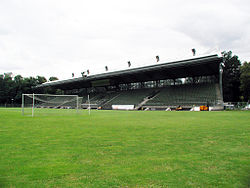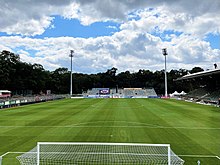 The stadium's main stands | |
|
| |
| Former names | Flughafenstadion (1990s) |
|---|---|
| Location | Cologne, Germany |
| Owner |
City of Cologne (1931–1999) Kölner Sportstätten GmbH (1999–present) |
| Operator | Kölner Sportstätten GmbH |
| Capacity | 8,343 |
| Surface | Grass |
| Construction | |
| Broke ground | 1931 |
| Opened | 20 September 1931 |
| Renovated | 2011, 2012, 2019, 2021 |
| Tenants | |
|
Viktoria Köln Cologne Crocodiles TuS Köln rrh. | |

Sportpark Höhenberg is a sports facility in the Merheimer Heide in Cologne's Höhenberg quarter on the right bank of the Rhine. The football stadium belonging to the facility is the home ground of association football club Viktoria Köln and American football team Cologne Crocodiles. Currently, the sports facility seats 8,343. [1] [2] [3]
The facility
The first sports facility was opened in August 1921. The "VfR-Stadion" built by VfR Köln was designed purely as a football stadium and had a capacity of 30,000 spectators. As part of the Green Belt expansion, the stadium was converted into an athletics stadium between 1929 and 1931 and the capacity was reduced to 18,000 seats. The reopening as "Sportpark Höhenberg" took place on 20 September 1931 in front of 8,000 spectators with a friendly match between VfR Köln and Schalke 04. There was a seating grandstand for the first time in 1969, when a roofed steel tube grandstand for approx. 1,200 spectators were erected. Shortly afterward, the back straight, which like the rest of the stadium had consisted only of grass walls, was also fixed with standing crossbars. This reduced the capacity to 12,000.
At the end of the 1980s, a new 3,000-seat grandstand was built and the back straight was further reinforced. To make room for the new stand, the running track was removed and the pitch moved towards the back straight. Since then, it has once again been a pure football stadium, as it opened in 1921, with up to 15,000 seats at times.
The sports facility has an artificial turf pitch and six tennis courts. In the 1990s, the stadium was temporarily called Flughafenstadion (airport stadium), as Cologne Bonn Airport, the main sponsor of VfR Köln's successor, then- Regionalliga team Preußen Köln, had acquired the naming rights. Although the company was once again the main sponsor of Preußen's successor club Viktoria Köln between 2011 and 2015, the name was not changed again. [4] The operator of the facility is the Kölner Sportstätten GmbH. In 2011, the facility was renovated for NRW-Liga matches. In May 2012, the back straight was renovated and a floodlight system was installed to make the stadium suitable for the Regionalliga West. According to the operator, the total costs amounted to around 1.5 million euros.
After Viktoria Köln was promoted to the 2019–20 3. Liga, the stadium was expanded to the required number of 10,001 seats by adding additional stands. [5] [6] [2] [3]
In summer 2021, a new pitch turf including turf heating was laid. The sprinkler system was also renewed. For the rugby and American football matches, two additional foundations, each one metre deep, were laid into which the field goals can be inserted. [7]
After the DFB reduced the minimum capacity for the 3. Liga to 5,000 for the 2022–23 season, a part of the new south stand construction was removed again. [8] Since then, the stadium can hold up to 8,343 spectators, of which 5,117 are standing and 3,226 are seated.
Immediately to the south is the club-owned facility of TuS Köln rrh. with two football pitches, one of which is surrounded by a blue tartan track, and several tennis courts. Although spatially the facility belongs to Sportpark Höhenberg, it is often not counted as part of it because of a different owner.
Use
The stadium is the home ground of Viktoria Köln. In addition, almost all predecessor clubs have played at least some of the time at Sportpark Höhenberg. During the 2005 FIFA Confederations Cup and the 2006 FIFA World Cup, the national teams of Tunisia, Japan and France used the stadium for training sessions. Manchester United also used the sports park in August 2020 for training sessions ahead of their semi-final match against Sevilla in the 2019–20 UEFA Europa League. [9]
Sportpark Höhenberg has hosted at least one rugby union international match every year since 2016. On 19 March 2016, the stadium hosted the 2014–2016 European Nations Cup First Division match Germany against Spain. The sold-out match in front of 6,214 spectators ended in a 17–17 draw. [10] On 11 March 2017, the German national rugby team played another international match against Spain as part of the 2016–17 Rugby Europe International Championships, with Spain prevailing 32–15. [11] As part of the 2017–18 Rugby Europe International Championships, the German national rugby team met Russia on 18 March 2018. However, the match was lost 3–57 in front of a crowd of around 2,600. Most recently, Germany played Spain again on 17 March 2019 as part of the 2018–19 Rugby Europe International Championships, but again lost the match 10–33. Since 2016, RSV Köln has been responsible for hosting the international matches in rugby union.
Starting in the 2021–22 season, Sportpark Höhenberg was selected as the final stadium of the Middle Rhine Cup; the Middle Rhine Football Association settled on the stadium until 2026. [12]
Transport
Sportpark Höhenberg is located on Frankfurter Straße, the Bundesstraße 8. About 900 m away is an access road to the B 55a, which leads to the Autobahn interchange Köln-Ost after one kilometre. The Höhenberg Frankfurter Straße stop of the Cologne Stadtbahn line 1 and the bus lines 151 and 152 is only 300 m away from the stadium.
Awards
In 1993, the sports facility was awarded the international architecture prize of the International Olympic Committee and the International Association for Sports and Leisure Facilities, the IOC/IAKS Award. [13]
External links
- The stadium on Viktoria Köln's website
- Kölner Sportstätten GmbH – Sportpark Höhenberg
- Image gallery
- Stadion in Sportpark Höhenberg – Köln-Höhenberg
References
- ^ "Sportpark Höhenberg". viktoria1904.de (in German). Viktoria Köln. Retrieved 11 August 2023.
- ^ a b "Stadion im Sportpark Höhenberg – Köln-Höhenberg". europlan-online.de (in German). Retrieved 18 July 2019.
- ^ a b "Grünes Licht: Viktoria Köln darf am Höhenberg spielen". liga3-online.de (in German). Retrieved 18 July 2019.
- ^ "Hauptsponsor für Viktoria" (in German). Archived from the original on 6 February 2013.
- ^ Oer, Michael (21 May 2019). "So plant Viktoria Köln nach dem Aufstieg". liga3-online.de (in German). Retrieved 29 May 2019.
- ^ "Letzte Hürde genommen: Viktoria Köln bleibt in Höhenberg". stadionwelt.de (in German). 14 June 2019. Retrieved 14 June 2019.
- ^ "Viktoria Köln erhält eine Rasenheizung im Sportpark Höhenberg". stadionwelt.de (in German). 17 August 2021. Retrieved 18 August 2021.
- ^ "Kleinere Stadien, mehr Eigenkapital: DFB beschließt Maßnahmen für 3. Liga". kicker.de (in German). kicker. Retrieved 1 July 2023.
- ^ Duncker, Charlotte (15 August 2020). "Bubble Boys! Inside Man Utd's bizarre preparations for Europa League semi-final with Sevilla". goal.com. Retrieved 19 August 2021.
- ^ "ENC 2016: DRV XV schafft nach Unentschieden gegen Spanien den EM-Klassenerhalt" (in German). Archived from the original on 22 March 2016.
- ^ Krebs, Bernhard (13 March 2017). "Sportpark Höhenberg Dämpfer für die deutsche Rugby-Auswahl in Köln". rundschau-online.de. Kölnische Rundschau. Retrieved 29 May 2019.
- ^ "Bitburger-Pokalfinale bis 2026 im Sportpark Höhenberg". fvm.de (in German). Middle Rhine Football Association. 22 March 2022. Retrieved 23 March 2022.
- ^ "Stadion – Unsere Spielstätte in Köln-Höhenberg" (in German). Archived from the original on 14 May 2012.